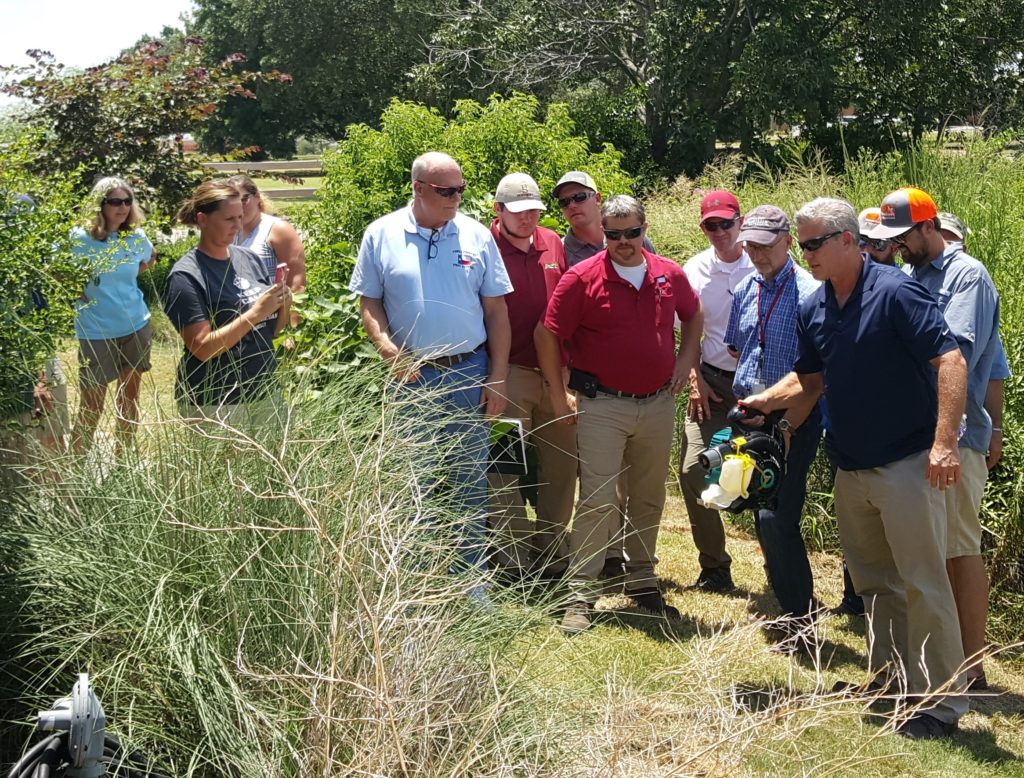
Keith Haas demonstrates use of a handheld ULV applicator to the class.
For which important urban insect pest did 70% of pest control companies get more calls last year? For which pest are 88% of pest management professionals (PMPs) confident that control options are better than they were five years ago? For what pest do nearly 2/3 of companies have callback rates of 4% or less?
According to a 2017 report by MGK® Co., the repeated answer is “mosquitoes”. It appears that pest control customers increasingly want to fight pesky mosquitoes in their backyards, and are willing to pay for it.
Ultimately, this increased interest in mosquitoes is what brought 15 interested PMPs to the “Practical Mosquito Control” course last week at IPM Experience House. And, as students learned, the driving force for this demand may just be the tiny Asian tiger mosquito (ATM), Aedes albopictus, and its slightly less common cousin the yellow fever mosquito, Aedes aegypti.
A fast and opportunistic biter, tiger mosquitoes are relatively new pests, having arrived from Japan only about 30 years ago. When people complain that, “the mosquitoes are terrible this time of year”, chances are they’re talking about the day-flying ATM. But ironically, despite it’s irritating bite, ATM is not currently a public health threat in most areas.
“The one good thing about ATM”, said Scott Sawlis, county entomologist for Dallas County Health and Human Services, “is that it reminds people that they need to wear repellent, and thereby protect themselves from the more dangerous disease-carrying species.” In the Dallas area that would be Culex quinquefasciatus, the stealthier, nighttime-flying, southern house mosquito. Even though folks don’t tend to notice the house mosquito as much, it’s the one to carry West Nile virus, our most serious mosquito-borne disease.
Sawlis and fellow instructors (myself and Dr. Sonja Swiger with TExas A&M AgriLife, and Keith Haas, with Central Life Sciences), spent the day explaining to class attendees about the need for mosquito control, and some of the differences between the target species. At the end of the day we got to practice what we learned in class by conducting an outdoor inspection and spending some workout time on microscopes looking at these tiniest of pests at a bug eye level.
During our inspection we discovered mosquitoes breeding (naturally) just a few feet from where class took place. Afterwards, students got to see fresh-caught mosquito eggs and watch mosquito larvae wriggle through murky breeding media. Haas demonstrated the ability of a ULV generator to go through and around landscape vegetation, and Sawlis demonstrated proper use of a dipper when trying to determine whether mosquitoes might be breeding in a water source.
Although ATM may be one of the best things to happen to the pest control business in the past few years, it does have a darker side. The ATM is very difficult to control from city spray trucks and even from the air. And it remains ready to transmit the viruses for Zika and dengue fever, should these diseases arrive in our area like Zika did last summer in Miami, FL and Brownsville, TX.
One of the most effective tools, our class learned, for fighting tiger mosquitoes is the PMP. While county and city mosquito control staff must patrol streets with sprayers that treat city-blocks at a time (a technique that works well for the house mosquito), only the PMP walks backyards, identifies and treats ground-level breeding sites, and precisely targets sprays to ATM resting sites. This puts the pest control technician in an important role to reduce the most frequent mosquito bites, and to fight Zika and other Aedes-borne illnesses, should they arise here.